Chapter 15 Tracing of Curves
15.1 Exercise 8
While tracing cartesian curves, look for mnemonic SONTRAD:
- Symmetry
- Origin
- Noticeable points
- Tangents
- Region
- Asymptotes
- Derivatives- first and second
To outline a general technique, we take these in turn.
- Where it crosses the -axis: The xx-axis has equation y=0y=0 and the curve has equation y=f(x)y=f(x), so the curve crosses the xx-axis at the points (x,0)(x,0) for which f(x)=0f(x)=0. Thus we solve the equation f(x)=0f(x)=0. This may have many solutions or none at all. (For instance, if f(x)=sinxf(x)=sinx there are infinitely many solutions, whereas if f(x)=x2+1f(x)=x2+1 there are none.)
- Where it crosses the yy-axis: The yy-axis has equation x=0x=0 and the curve has equation y=f(x)y=f(x) , so the curve crosses the yy-axis at the single point (0,f(0))(0,f(0)).
- Finding the critical points: We have seen how to do this already. We solve the equation f′(x)=0f′(x)=0.
- The natures of the critical points: This means determining whether each one is a local maximum, local minimum, or inflexion point.
- Limiting behaviour: We have to determine what happens to f(x)f(x) as xx tends to infinity and as xx tends to minus infinity; in other words, we have to ask how f(x)f(x) behaves for xx far to the right on the xx-axis and for xx far to the left on the negative side of the axis.
As far as the last point (limiting behaviour) is concerned, there are two standard results here which are useful.
First, the behaviour of a polynomial function is determined solely by its leading term, the one with the highest power of xx. This term dominates for xx of large absolute value. A useful observation is that if nn is even, then
xn→∞as x→∞and also as x→−∞xn→∞as x→∞and also as x→−∞
while if nn is odd,
f(x)→∞as x→∞and f(x)→−∞as x→−∞.f(x)→∞as x→∞and f(x)→−∞as x→−∞.
Secondly, whenever we have a function which is the product of an exponential and a power, the exponential dominates. Thus, for example, x2e−x→0x2e−x→0 as x→∞x→∞ (even though x2→∞x2→∞).
15.1.1 Question 1
Trace the following curves
- y=(x2−x−6)(x−7)y=(x2−x−6)(x−7)
- The equation can be written as y=(x−3)(x+2)(x−7)y=(x−3)(x+2)(x−7). So the curve passes through (3,0),(−2,0),(7,0)(3,0),(−2,0),(7,0).
- Does not pass through origin.
- When x=0x=0, y=42y=42. The curve passes through (0,42)(0,42).
- dydx=3x2−16x+1dydx=3x2−16x+1. So the tangents parallel to xx-axis are at
dydx=03x2−16x+1=0x=5.27,0.06dydx=03x2−16x+1=0x=5.27,0.06
the coordinates (5.27,28.55),(0.06,42.03)(5.27,28.55),(0.06,42.03)
- f″(x)=6x−16f′′(x)=6x−16. At $(5.27,28.55), f″(x)f′′(x) is positive, so this is minima and at (0.06,42.03)(0.06,42.03), f″(x)f′′(x) is negative, so this is maxima.
- The point of inflection
f″(x)=06x−16=0x=2.67f′′(x)=06x−16=0x=2.67
So at point (2.67,6.67)(2.67,6.67), the curve changes concavity from downward to upward.
When x→∞x→∞, y→∞y→∞.
When x→−∞x→−∞, y→−∞y→−∞.
With all these information, the curve can be easily plotted as below:
Figure 15.1: Tracing of y=(x2−x−6)(x−7)y=(x2−x−6)(x−7)
- 2x−3x2−3x+22x−3x2−3x+2
- The equation can be written as
y=2x−3(x−1)(x−2)y=2x−3(x−1)(x−2)
The curve is not symmetric around xx or yy-axis.
Does not pass through the origin.
Vertical asymptotes are x=1x=1 and x=2x=2.
When x=0x=0, y=−3/2y=−3/2
When y=0y=0, x=3/2x=3/2
When x→+∞x→+∞, y→+0y→+0 and when x→−∞x→−∞, y→−0y→−0
When x→1−x→1−, y→−∞y→−∞ and when x→1+x→1+, y→+∞y→+∞
When x→2−x→2−, y→−∞y→−∞ and when x→2+x→2+, y→+∞y→+∞
For maxima, minima
dydx=2(x−1)(x−2)−(2x−3)(x−2)−(2x−3)(x−1)(x−1)2(x−2)2dydx=2(x−1)(x−2)−(2x−3)(x−2)−(2x−3)(x−1)(x−1)2(x−2)2
Setting dydx=0dydx=0
2(x−1)(x−2)−(2x−3)(x−2)−(2x−3)(x−1)(x−1)2(x−2)2=02x2−6x+5=02(x−1)(x−2)−(2x−3)(x−2)−(2x−3)(x−1)(x−1)2(x−2)2=02x2−6x+5=0
xx is not defined, so the function does not have maxima or minima.
Thus the curve can be traced as shown below:
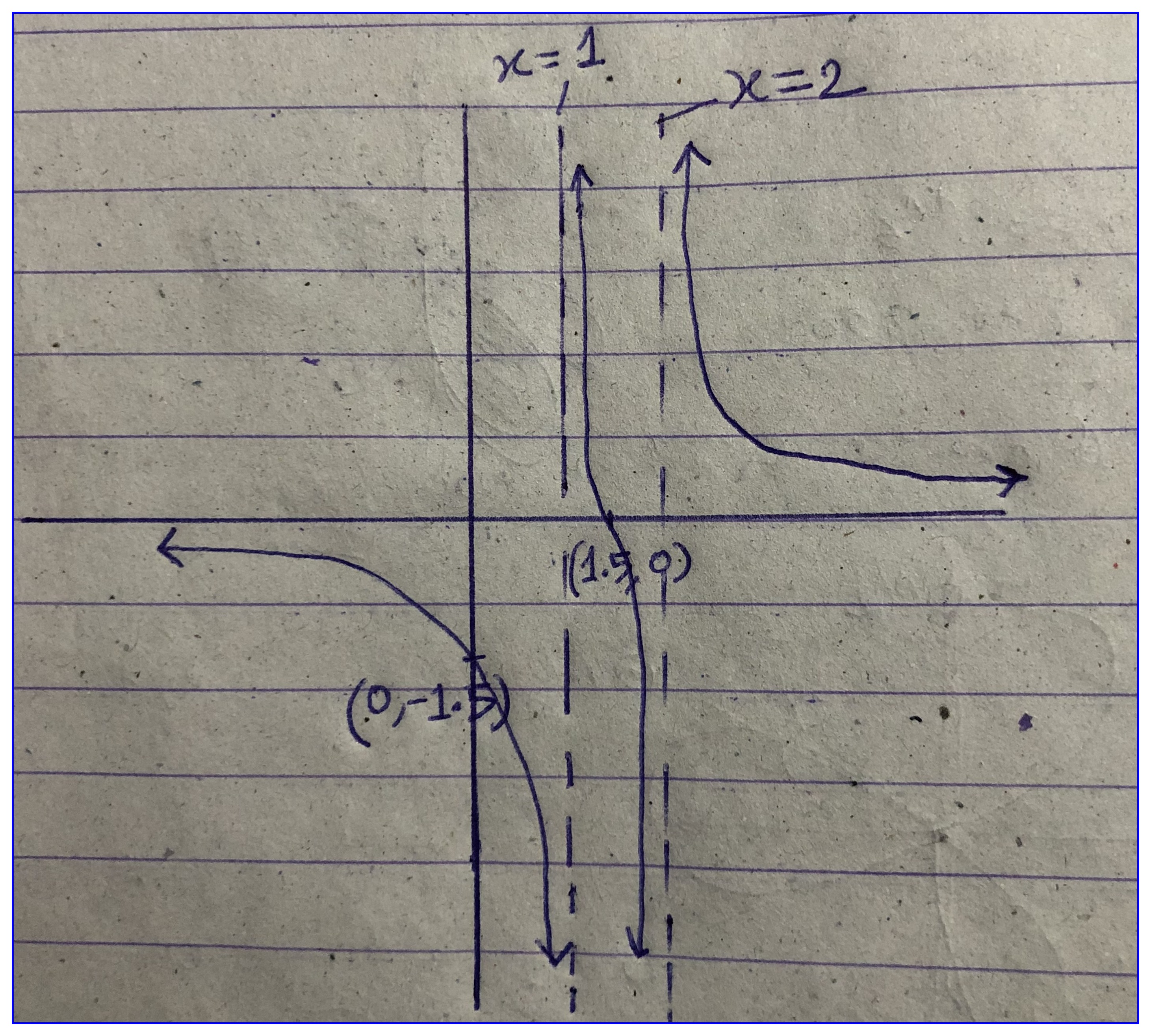
Figure 15.2: y=2x−3x2−3x+2y=2x−3x2−3x+2
- y2(a−x)=x2(a+x)y2(a−x)=x2(a+x)
The curve is symmetric about xx-axis because the power of y is only even.
Passes through origin.
Tangents at origin are found by equating least powers of xx and yy to 00
y2a−x2a=0y=±xy2a−x2a=0y=±x
When y=0y=0, x=0,−ax=0,−a
Domain: As the equation can also be written as y=√x2(a+x)a−xy=√x2(a+x)a−x, the function won’t have real values if x>ax>a or x<−ax<−a. So the function is not defined in that region.
The vertical asymptote is x=ax=a.
When x→ax→a, y→±∞y→±∞
dydxdydx is ∞∞ at (−a,0)(−a,0). So the tangent is perpendicular at that point.
The curve is as shown below:
Figure 15.3: y2(a−x)=x2(a+x)y2(a−x)=x2(a+x)
- x2y2=x2−1x2y2=x2−1
The curve is symmetric about both xx and yy axes as the power of yy and xx are only even.
The equation can be written as y2=x2−1x2y2=x2−1x2. The function is thus not defined between (−1,1)(−1,1).
When x=−1,y=0x=−1,y=0 and x=1,y=0x=1,y=0
When x→∞x→∞, y=±1y=±1 and when x→−∞x→−∞, y=±1y=±1.
Asymptotes parallel to xx-axis
y2−1=0y=±1y2−1=0y=±1
- dydx=1−y2xydydx=1−y2xy. Its value at (−1,0)(−1,0) and at (1,0)(1,0) is ∞∞. So the tangents at these points are perpendicular at these points.
With this information, the curve can be easily traced as follows:
Figure 15.4: x2y2=x2−1x2y2=x2−1
- x2(x2+y2)=a2(x2−y2)x2(x2+y2)=a2(x2−y2)
The curve is symmetric about both xx and yy-axes as powers of yy and xx are only even.
Passes through origin.
Tangents at origin
x2a2=y2a2y=±xx2a2=y2a2y=±x
No asymptotes parallel to xx or yy axis.
When y=0y=0, x=±ax=±a. Passes through (a,0)(a,0) and (−a,0)(−a,0).
The equation can be written as y2=x2a2−x4x2+a2y2=x2a2−x4x2+a2. Thus curve is not defined when x>ax>a or x<−ax<−a.
To find the slope of tangents at (a,0)(a,0) and (−a,0)(−a,0), let us find dydxdydx
dydx=a2x−2x3x2y+a2ydydx=a2x−2x3x2y+a2y
Slope of tangents at (a,0)(a,0) and (−a,0)(−a,0) is ∞∞. Thus tangents are perpendicular at these points.
The curve is plotted as shown below:
Figure 15.5: x2(x2+y2)=a2(x2−y2)x2(x2+y2)=a2(x2−y2)
- y2=x3(4−x)y2=x3(4−x)
The curve is symmetric around xx-axis as the power of y is only even i.e equal to 22.
Passes through origin.
No asymptotes parallel to xx or yy axis.
When y=0y=0, x=0x=0 and x=4x=4. The curve thus passes through (0,0)(0,0) and (4,0)(4,0).
The curve is not defined at x<0x<0 and x>4x>4.
dydxdydx
2ydydx=12x2−4x3dydx=6x−2x2√x(4−x)2ydydx=12x2−4x3dydx=6x−2x2√x(4−x)
The tangents to the curve are parallel to the xx-axis at dydx=0dydx=0
6x−2x2√x(4−x)=02x2−6x=0x(x−3)=0x=0,36x−2x2√x(4−x)=02x2−6x=0x(x−3)=0x=0,3
So at (0,0),(3,5.2)(0,0),(3,5.2) and (3,−5.2)(3,−5.2) tangents are parallel to xx-axis.
At (4,0)(4,0), dydx=∞dydx=∞. So tangent is perpendicular at this point.
= . At (3,5.2)(3,5.2), f″(x)f′′(x) is negative, therefore it is maxima and at (3,−5.2)(3,−5.2), f″(x)f′′(x) is positive, therefore it is minima.
Point of inflection is where f″(x)=0f′′(x)=0
f″(x)=06x2−12x=0x(x−2)=0x=0,2f′′(x)=06x2−12x=0x(x−2)=0x=0,2
So (0,0)(0,0) and (2,4)(2,4) are points of inflection where curve changes concavity.
Thus we completed the upper half of this curve. As it is symmetric to xx-axis, the lower half can be plotted as a reflection of upper half.
Thus curve is easily plotted as shown below:
Figure 15.6: y2=x3(4−x)y2=x3(4−x)
Few famous curves:
- Folium of Descartes
- Cissoid of Diocles
- Witch of Agnesi
- Strophoid
15.1.2 Question 2
Trace the following curves
- a2b2+x2y2=a2x2a2b2+x2y2=a2x2
The curve is symmetric about both xx and yy axes.
Does not pass through origin.
The equation can be written as y2=a2x2−a2b2x2y2=a2x2−a2b2x2. The curve is thus not defined in the interval (−b,b)(−b,b). It is defined only for x≥bx≥b and x≤−bx≤−b.
When y=0y=0, x=±bx=±b. The curve thus passes through (b,0)(b,0) and (−b,0)(−b,0).
Asymptotes parallel to xx-axis are y=±ay=±a.
dydx=a2−y2xydydx=a2−y2xy. So at point (b,0)(b,0) and (−b,0)(−b,0), slope is ∞∞, so tangents are perpendicular at these two points.
The curve is thus plotted as:
Figure 15.7: a2b2+x2y2=a2x2a2b2+x2y2=a2x2
- x2(a2+y2)=y(a2−y2)x2(a2+y2)=y(a2−y2)
The curve is symmetric around yy-axis.
When x=0x=0, y=0,±ay=0,±a. The curve passses through points (0,0)(0,0) (origin), (0,a)(0,a) and (0,−a)(0,−a).
No asymptotes parallel to xx-axis.
No asymptotes parallel to yy-axis.
Domain: x2=y(a2−y2)a2+y2x2=y(a2−y2)a2+y2. So when y>ay>a or yy lies in the interval (0,−a)(0,−a), the curve is not defined.
dydx=2a2x+2xy2a2−3y2−2x2ydydx=2a2x+2xy2a2−3y2−2x2y. At the points (0,0)(0,0) (origin), (0,a)(0,a) and (0,−a)(0,−a), the tangents are parallel to xx-axis.
When y→−∞y→−∞, x→±∞x→±∞.
The curve is thus plotted as below:
Figure 15.8: x2(a2+y2)=y(a2−y2)x2(a2+y2)=y(a2−y2)
- y2=x2(a2−x2)y2=x2(a2−x2)
Symmetric around both xx and yy axes.
Passes through the origin.
When y=0y=0, x=0,±ax=0,±a. So the curve passes through (0,0)(0,0), (a,0)(a,0) and (−a,0)(−a,0).
The function not defined when x>ax>a and x<−ax<−a.
No asymptotes parallel to xx or yy axis.
Slope
dydx=a2x−2x3y=±a2−2x2√a2−x2dydx=a2x−2x3y=±a2−2x2√a2−x2
Slope at origin (0,0)(0,0) is ±a±a.
Slope at (a,0)(a,0) and (−a,0)(−a,0) is ∞∞. So tangents to the curve at these points are perpendicular to xx-axis.
dydx=0dydx=0 is at x=±a√2x=±a√2. The tangents are parallel to xx-axis at x=±a√2x=±a√2 and y=±a22y=±a22.
Point of inflection
d2ydx2=a2−6x2y+1d2ydx2=a2−6x2y+1
d2ydx2=0a2−6x2y+1=0x=±a√6d2ydx2=0a2−6x2y+1=0x=±a√6
The point of inflection is (±a√6,±√5a26)(±a√6,±√5a26).
With this information curve is easily plotted as follows:
Figure 15.9: y2=x2(a2−x2y2=x2(a2−x2
- y2=x3y2=x3
The curve is symmetric about xx-axis.
Domain: [0,∞)[0,∞)
Passes through origin.
When x→∞x→∞, y→±∞y→±∞.
dydx=±32√xdydx=±32√x. dydx=0dydx=0 at x=0x=0 i.e at origin.
So as xx increases slope also increases.
No asymptotes parallel to xx or yy axis.
d2ydx2=3xy+1d2ydx2=3xy+1. The point of inflection is at x=0x=0.
The graph is easily plotted as:
Figure 15.10: y2=x3y2=x3
- y2=(x−2a)3y2=(x−2a)3
The curve is symmetric about xx-axis.
Does not pass through origin.
When y=0y=0, x=2ax=2a. Passes through (2a,0)(2a,0).
Domain: [2a,∞)[2a,∞). Function not defined when x<2ax<2a.
dydx=±32√x−2adydx=±32√x−2a. It is 00 when x=2ax=2a.
Beyond x=2ax=2a, slope continuously increases.
Point of inflection is x=2ax=2a.
No asymptotes parallel to xx or yy axis.
The curve is as shown below:
Figure 15.11: y2=(x−2a)3y2=(x−2a)3
- x2y2=a2(y2−x2)x2y2=a2(y2−x2)
The curve is symmetric about both xx and yy axes.
Passes through origin.
No asymptotes parallel to xx-axis.
Asymptotes parallel to yy-axis are x=±ax=±a.
Domain of the given function y2=a2x2a2−x2y2=a2x2a2−x2 is (−a,a)(−a,a). It is not defined when x≥ax≥a or x≤−ax≤−a.
When x→a−x→a−, y→±∞y→±∞.
When x→−a+x→−a+, y→±∞y→±∞.
The curve is as shown below:
Figure 15.12: x2y2=a2(y2−x2)x2y2=a2(y2−x2)
- y2=x2(a−x)y2=x2(a−x)
The curve is symmetric around xx-axis.
Passes through origin.
When y=0y=0, x=0,ax=0,a. The curve thus passes through (0,0)(0,0), (a,0)(a,0).
Domain: (−∞,a](−∞,a].
dydxdydx
dydx=±2a−3x2√a−xdydx=±2a−3x2√a−x
dydx=0dydx=0 when x=2a3x=2a3. When x=2a3x=2a3, y=±√4a327y=±√4a327. Thus tangents are parallel to xx-axis at points (x=2a3,√4a327)(x=2a3,√4a327) and (x=2a3,−√4a327)(x=2a3,−√4a327).
Point of inflection is where f″(x)=0f′′(x)=0. In this case it is at x=a3x=a3.
dydxdydx at origin is ±√a±√a.
dydxdydx at (a,0)(a,0) is ∞∞. Tangent is thus perpendicular here.
The curve thus can be very easily plotted as shown below:
Figure 15.13: y2=x2(a−x)y2=x2(a−x)
15.1.3 Question 3
Trace the following curves
- r=a(1−cosθ)r=a(1−cosθ)
- cosθcosθ can range from −1−1 to 11. So rr cannot be more 2a2a.
- Replacing θθ with −θ−θ does not change the equation, so the curve is symmetric about the initial line i.e θ=0θ=0 line.
- Values of rr at different θθ values
| θθ | rr |
|---|---|
| 00 | 00 |
| π/4π/4 | a(1−1/√2)≈0.29aa(1−1/√2)≈0.29a |
| π/3π/3 | a/2=0.5aa/2=0.5a |
| π/2π/2 | aa |
| ππ | 2a2a |
| 2π2π | 00 |
- To find the tangents, we have to find tanϕ=rdθdrtanϕ=rdθdr
tanϕ=rdθdr=tanθ2ϕ=θ2tanϕ=rdθdr=tanθ2ϕ=θ2
And
ψ=ϕ+θψ=θ2+θ=3θ2ψ=ϕ+θψ=θ2+θ=3θ2
The angle that tangents make at θθ are:
| θθ | ψψ |
|---|---|
| 00 | 00 |
| ππ | 3π/23π/2 |
- Value of rr progressively increases from θ=0θ=0 to θ=πθ=π.
- As the curve is symmetric about initial line, the curve can be plotted as below:
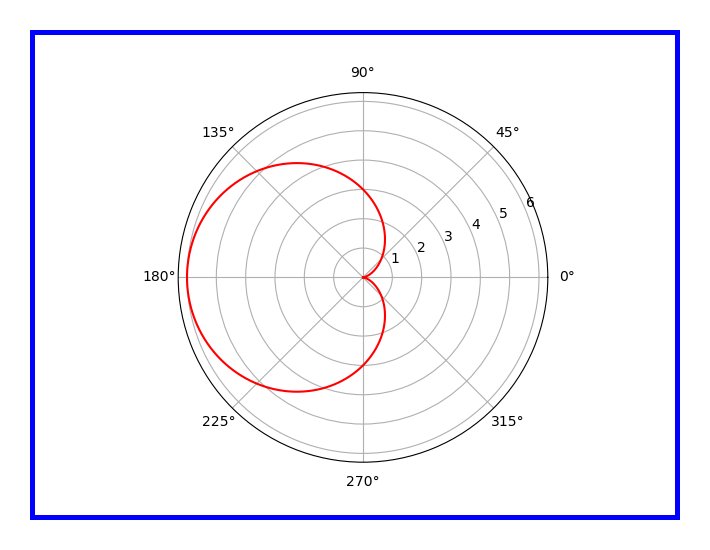
Figure 15.14: Plotting of r=a(1−cosθ)r=a(1−cosθ)
- r2=a2sin2θr2=a2sin2θ
- On replacing rr by −r−r, the equation does not change, so the curve is symmetrical about pole (called as origin in cartesian system).
- r2r2 is negative when sin2θsin2θ is negative i.e when θθ lies in open interval (π,2π)(π,2π) and (3π2,2π)(3π2,2π). Thus the curve has no portion in these region.
- We know
tanϕ=rdθdrtanϕ=r2a2cos2θtanϕ=tan2θϕ=2θtanϕ=rdθdrtanϕ=r2a2cos2θtanϕ=tan2θϕ=2θ
and
ψ=ϕ+θψ=2θ+θψ=3θψ=ϕ+θψ=2θ+θψ=3θ
| θθ | ψψ |
|---|---|
| 00 | 00 |
| π/2π/2 | 3π/23π/2 |
| ππ | 3π3π |
| 3π/23π/2 | 9π/29π/2 |
- rr increases when θθ increases from 00 to π/4π/4. rr will have two values for each θθ in the region where curve is defined.
With these information curve is plotted as shown below:
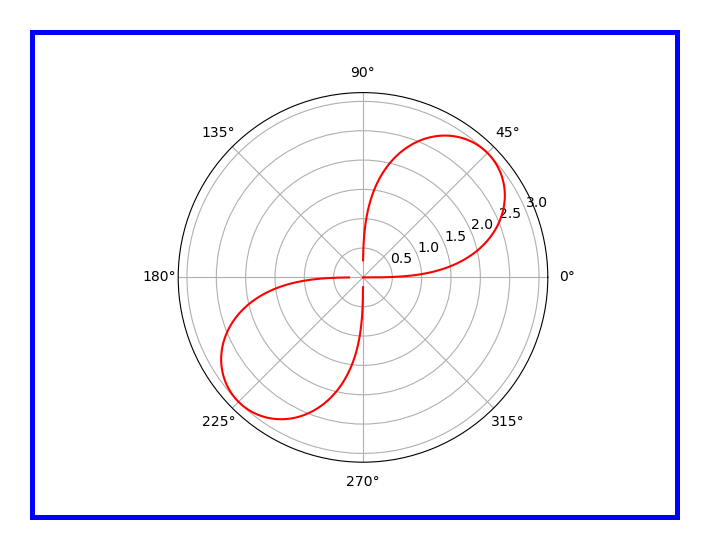
Figure 15.15: Plotting of r2=a2sin2θr2=a2sin2θ
- To trace curves of the form r=asinnθr=asinnθ or r=acosnθr=acosnθ, know that since sinnθsinnθ or cosnθcosnθ cannot be greater than one in both the cases rr cannot be greater than aa. Hence, the curve wholly lies within the circle of radius aa.
- To find the curve r=asinnθr=asinnθ put r=0r=0. Then nθ=0,π,2π,⋯nθ=0,π,2π,⋯ θ=0,πn,2πn,⋯θ=0,πn,2πn,⋯ Draw these lines. If nn is odd there are nn loops in alternate divisions and if nn is even there are 2n2n loops one in each division.
- To trace the curve r=acosnθr=acosnθ put r=0r=0 Then, nθ=−π2,π2,3π2,5π2,⋯θ=−π2n,π2n,3π2n,5π2n,⋯nθ=−π2,π2,3π2,5π2,⋯θ=−π2n,π2n,3π2n,5π2n,⋯
Draw these lines. If nn is odd there are nn loops in alternate divisions and if nn is even there are 2n2n loops one in each division.
- r=acos2θr=acos2θ
- Since cos2θcos2θ cannot be greater than 11 (as cosine values range from −1−1 to 11), rr cannot be greater than aa.
- Replacing θθ with −θ−θ does not change the equation, so the curve is symmetric about the initial line.
- It is of form r=acosnθr=acosnθ, with nn being even so the equation has 44 loops.
- Putting r=0r=0, then
cos2θ=02θ=π2,3π2,5π2,7π2,⋯θ=π4,3π4,5π4,7π4,⋯cos2θ=02θ=π2,3π2,5π2,7π2,⋯θ=π4,3π4,5π4,7π4,⋯
Draw these lines, and as 22 is even there are total 44 loops one in each division.
Figure 15.16: Plotting of r=acos2θr=acos2θ
- r=acos3θr=acos3θ
- Since cos3θcos3θ cannot be greater than 11, rr cannot be greater than aa.
- Replacing θθ with −θ−θ does not change the equation, so the curve is symmetric about the initial line.
- It is of form r=acosnθr=acosnθ, so the equation has 33 loops.
- Putting r=0r=0, then
cos3θ=03θ=π2,3π2,5π2,7π2,⋯θ=π6,3π6,5π6,7π6,⋯cos3θ=03θ=π2,3π2,5π2,7π2,⋯θ=π6,3π6,5π6,7π6,⋯
Draw these lines, and as 33 is odd there are 33 loops in alternate divisions.
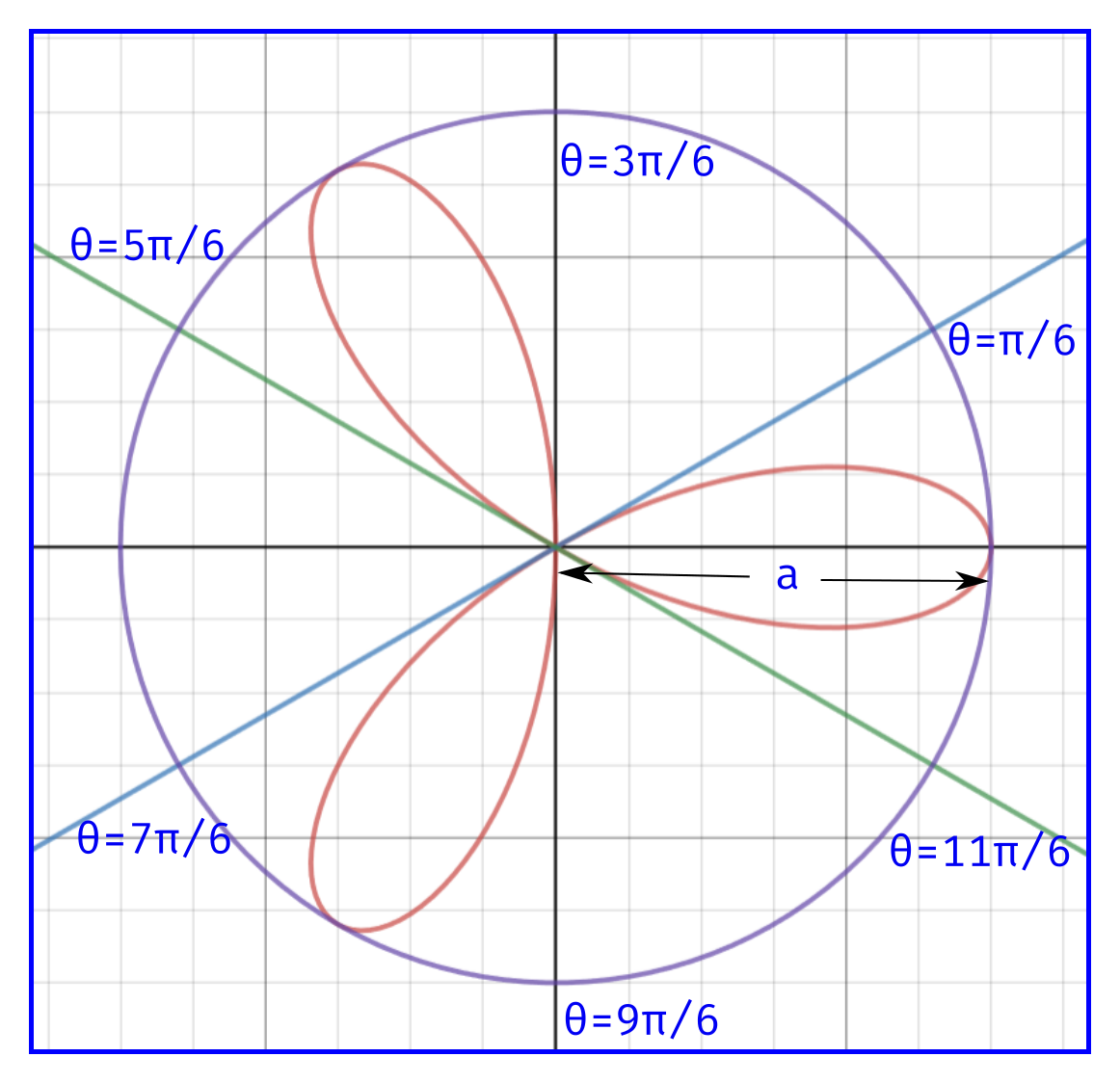
Figure 15.17: Plotting of r=acos3θr=acos3θ
15.1.4 Additional interesting questions
Trace the following curves
- y2(x−a)=x2(x+a)y2(x−a)=x2(x+a)
Please note y2(a−x)=x2(x+a)y2(a−x)=x2(x+a) gives a totally different curve. Try yourself !
- The curve is symmetric around xx-axis as power of yy is even.
- When y=0y=0, x=0,x=−ax=0,x=−a
- Domain: y2=x2(x+a)x−ay2=x2(x+a)x−a, the curve is not defined in the interval (0,a),(−a,0)(0,a),(−a,0).
- Asymptotes parallel to yy-axis is obtained by equating coefficients of y2y2, x=ax=a
- The oblique asymptotes are (see chapter 13 for tricks: method of substitution of x=1x=1, y=my=m) are y=x+ay=x+a and y+x+a=0y+x+a=0.
- dydxdydx
y=x(x+a)1/2(x−a)1/2dydx=(x−a)1/2[x2(x+a)1/2+(x+a)1/2]−x(x+a)1/2×12(x−a)1/2x−adydx=(x−a)1/2[x+2(x+a)2(x+a)1/2]−x(x+a)1/22(x−a)1/2x−ay=x(x+a)1/2(x−a)1/2dydx=(x−a)1/2[x2(x+a)1/2+(x+a)1/2]−x(x+a)1/2×12(x−a)1/2x−adydx=(x−a)1/2[x+2(x+a)2(x+a)1/2]−x(x+a)1/22(x−a)1/2x−a Tangents to the curve is at where dy/dx=0dy/dx=0, so
(x−a)1/2[x+2(x+a)2(x+a)1/2]−x(x+a)1/22(x−a)1/2=0(x−a)1/2[x+2(x+a)2(x+a)1/2]=x(x+a)1/22(x−a)1/22(x−a)(3x+2a)=2x(x+a)3x2+2ax−3ax−2a2=x2+axx2−ax−a2=0(x−a)1/2[x+2(x+a)2(x+a)1/2]−x(x+a)1/22(x−a)1/2=0(x−a)1/2[x+2(x+a)2(x+a)1/2]=x(x+a)1/22(x−a)1/22(x−a)(3x+2a)=2x(x+a)3x2+2ax−3ax−2a2=x2+axx2−ax−a2=0 So the value of xx, where slope is 00 are:
x=a±√a2+4a22=a(1±√52)x=1.61a,−0.62ax=a±√a2+4a22=a(1±√52)x=1.61a,−0.62a
Of the two xx-values, −0.62a−0.62a does not lie within the domain of the given function, so we reject it.
As x>1.61ax>1.61a, the value of numerator in y2=x2(x+a)x−ay2=x2(x+a)x−a increases faster than the denominator. Hence value of yy increases more for even a small increase in xx. Thus slope increases as xx increases beyond x>1.61ax>1.61a.
At x=1.61ax=1.61a, y=±3.33ay=±3.33a.
We know
2ydydx=(x−a)[x2+(x+a)2x]+x2(x+a)(x−a)22ydydx=(x−a)[x2+(x+a)2x]+x2(x+a)(x−a)2
so at point (−a,0)(−a,0), dydx=∞dydx=∞ i.e. tangent is perpendicular at this point.
- As xx decreases from −a−a to −∞−∞, the value of yy also increases rapidly. And we know the curve is symmetric about xx-axis.
With all these information the curve is easily plotted below:
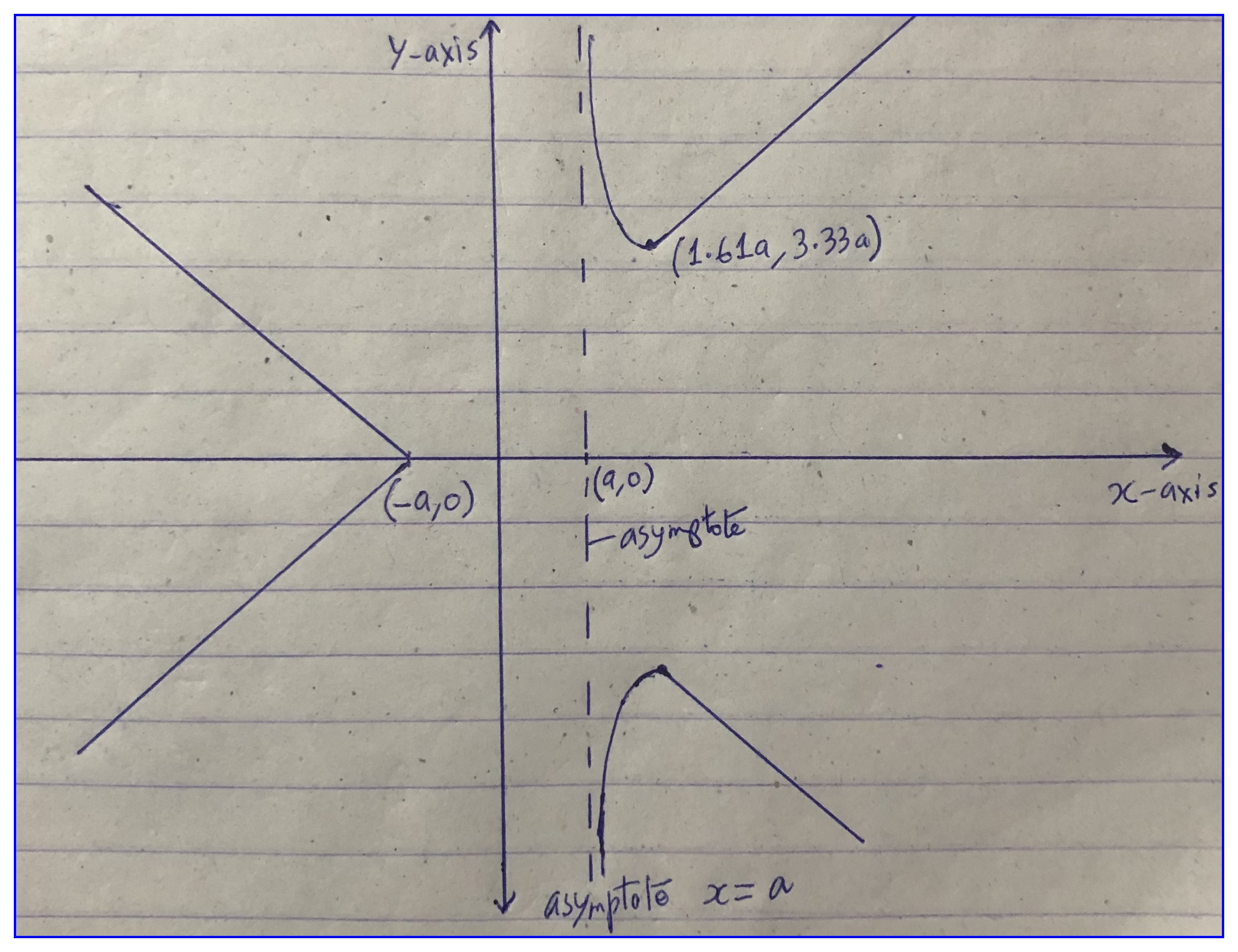
Figure 15.18: Curve for y2(x−a)=x2(x+a)y2(x−a)=x2(x+a)
- y2(x2−4)=x4y2(x2−4)=x4
- The curve is symmetric around both xx and yy-axes.
- As y2=x4x2−4y2=x4x2−4, the domain of the given function is (−∞,2)(−∞,2) and (2,∞)(2,∞). The function is not defined in the interval [−2,2][−2,2] except at the origin.
y2=x4x2−4y2=x4x2−4(15.1)
- The asymptotes parallel to y-axis are x=±2.
- No horizontal asymptotes
- The oblique asymptotes are y=x and y=−x.
- Working for dydx
y=x2(x2−4)1/2dydx=(x2−4)1/2×2x−x2×2x2(x2−4)1/2x2−4=4x(x2−4)−2x32(x2−4)3/2
To find maxima or minima,
dydx=04x(x2−4)−2x32(x2−4)3/2=04x(x2−4)=2x3x=±√8
When x=+√8, y=±4. When x=−√8, y=±4.
When x→2+, y→±∞.
When x→−2−, y→±∞.
As value of x>2 to +∞ or x<−2 to −∞ in equation (15.1) value of numerator increases rapidly than denominator i.e. for even small increase in x, increase in y is higher, so slope increases as x→∞ from >2. Hence curve will be concave upward. By symmetry the curve can be constructed as follow:
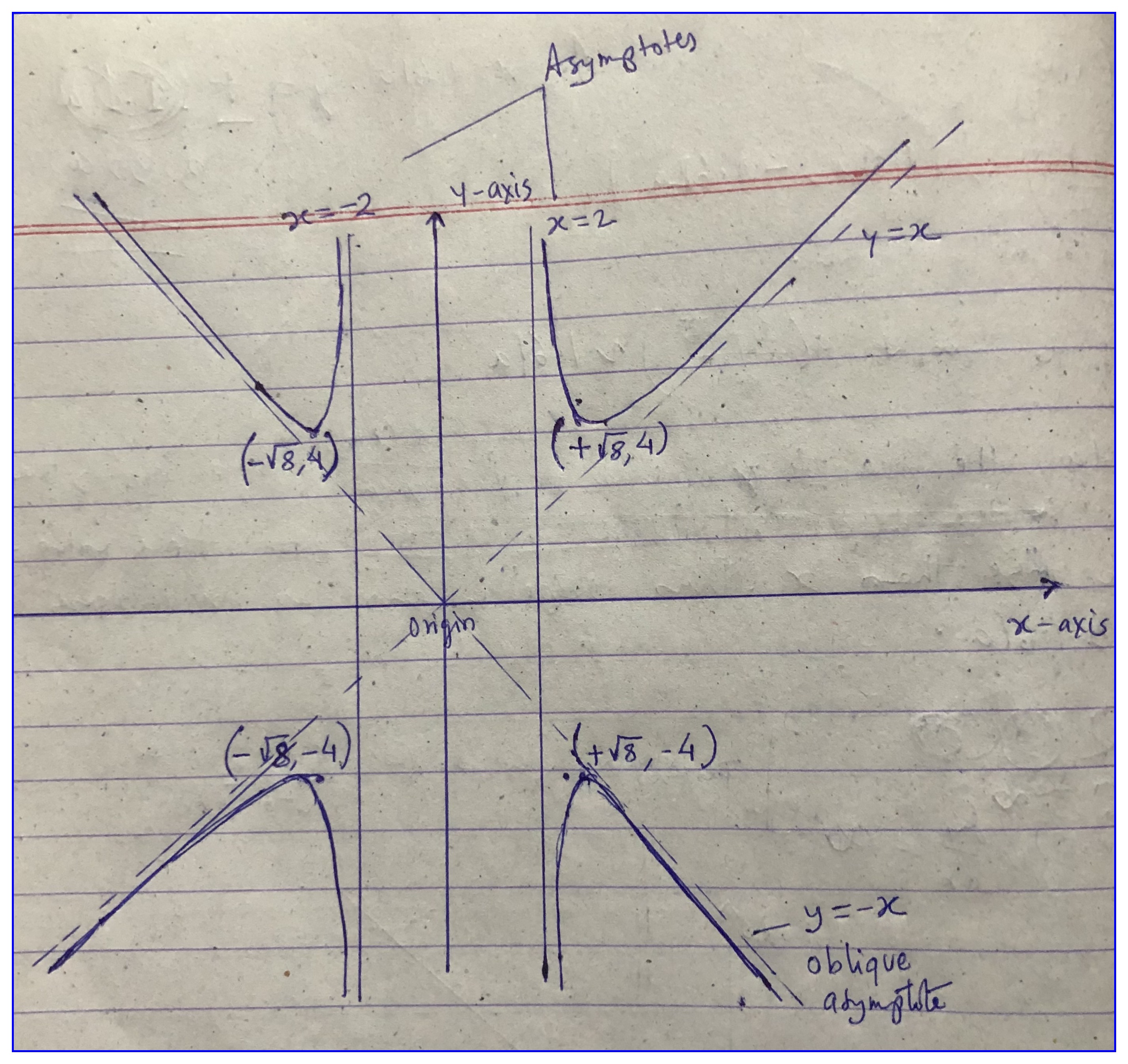
Figure 15.19: Curve of equation y2(x2−4)=x4
Reading this on math stackexchange is useful. It explains the essential concepts.